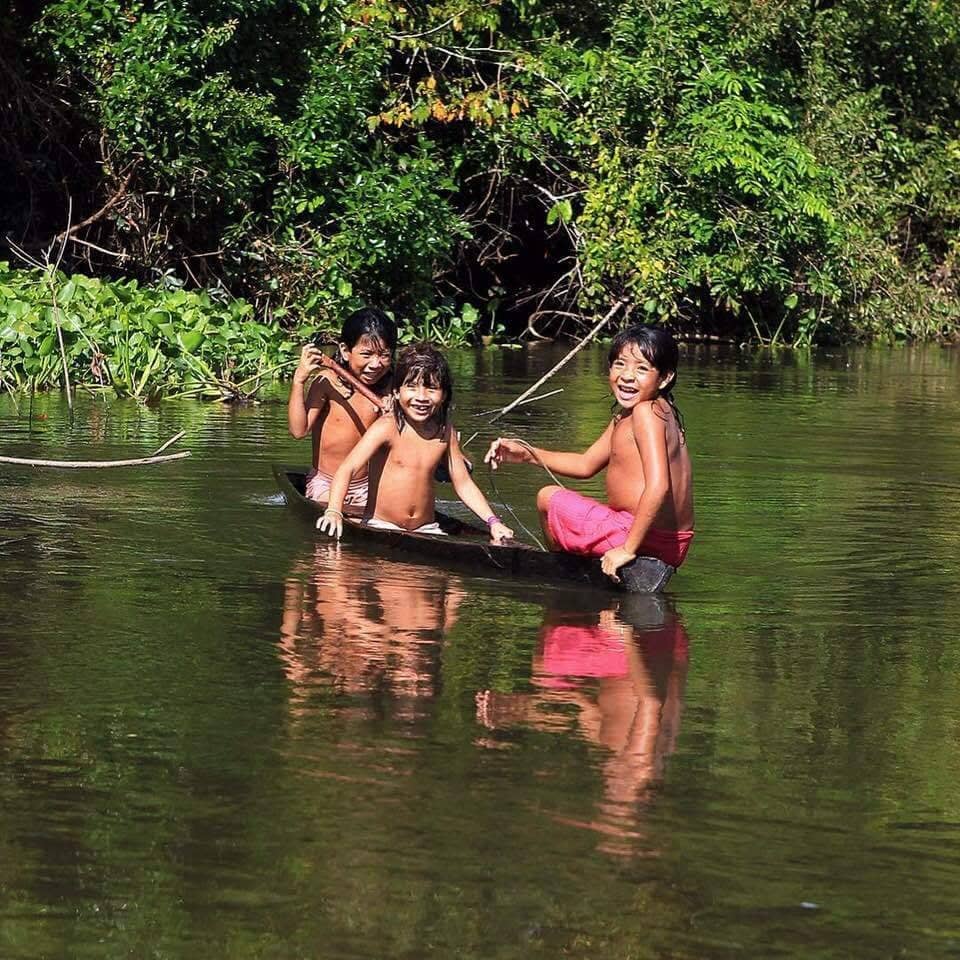
By Ravin Singh
I don’t think a ‘magga’ man like me plunging naked in one of the black water trenches in Guyana is the best image I want you to imagine.
But at least that’s what most of us from the country have done. If not naked, well at least with just our ‘Buckta’ on.
Men and women bathing along the trenches used to be a common sight in rural communities along the coast. Now with access to water in our yards and homes more readily available, the practice has ceased for the most part.
In the interior, however, this is still customary.

Imagine then, the horror for many in and out of Guyana, when a recent New York Times (NYT) writer described Guyana as a country where children “play naked in the muggy heat” to embellish a hyperbolic conclusion about the state of Guyana.
“Misrepresenting Guyana as ‘a place forgotten by time’ where ‘children play naked in the muggy heat’ denies its complexity,” says Oneka LaBenette, Associate Professor at Cornell University.
Among those who understand that complexity well is Jean La Rose, an award-winning advocate for the rights of Guyana’s indigenous peoples.
“Playing naked is… part of culture; it is done in the most innocent of ways,” she says.
“This cannot compare to the nudist beaches and hangouts that are seen as fashionable in some ‘developed’ countries.”
The reference in the NYT article about children paddling to school was also thrown in to paint a grim picture of Guyana.
La Rose explains that mode of transportation has a lot to do with the geography of Guyana, where, in some cases, it is simply impractical for some students in remote areas to get to school any other way.

Canoes are still used because it remains one of the most unique inventions of Indigenous peoples, given that it is both cost friendly and efficient.
“Also, being able to paddle a canoe is a matter of pride for those of us who come from riverine communities,” says La Rose.
“It is also a matter of culture and carrying on tradition; it is nothing for us to be ashamed of.”
Three years ago, as part of an initiative to help children get to school, President David Granger began handing out engine-operated boats for students in remote areas, thereby significantly reducing dependence on canoes.
The NYT article opens by describing Guyana as a “vast, watery wilderness with only three paved highways”. Although Guyana is known as the land of many waters, the impression conveyed was that infrastructure is severely lacking.
This was reinforced by the fact that the author, Clifford Kraus selectively chose to mention that the country has only three highways, but not that it has one of the tallest wooden buildings in the world – St. George’s Cathedral – or that it still has one of the longest floating bridge in the world – the Demerara Harbour Bridge. These facts are accessible online with the single click of a mouse.
In the second paragraph, Krauss describes Georgetown – the country’s capital – as a “musty clapboard town… which seems forgotten by time”.
In fact, Georgetown is home to a growing population of 125,000 people – one of the most populated cities in the English-speaking Caribbean. Communities sitting on the margins of Georgetown add another 185,000 people.
LaBenette, using Twitter, seized the opportunity to caution the writer, Clifford Krauss, that “dangerous distortions like this inform the perilous trajectory of my homeland’s oil boom.” She then called for The Times to do better in future publications.
Another “convenient,” albeit accurate claim by the writer was that “the power grid is so unreliable that blackouts are a regular plague in the cities”.
However, there was no mention of the development of a solar farm at Mabaruma – one of the same Indigenous villages – neither was there any mention of the inking of an agreement between the Guyana Government and that of Norway for the financing of solar projects that will generate 100 megawatts of power. There was also no mention of the fact that Guyana has been at the forefront of the global fight against climate change.
The writer then claims, inaccurately, that “in much of the countryside there is no electricity at all”.
In fact, a simple Google search would have brought up a 2016 World Bank collection of development indicators which revealed that 85 per cent of Guyana’s 744,000 population has access to electricity.
Of the remaining, 10 per cent benefit from renewable energy sources, while a portion of the other five per cent utilise generators and other equipment due to the exorbitant cost attached to developing infrastructure to provide electricity to those remote communities.
The writer then warns about the dangers of wasting the opportunities which arise from oil production, especially in states where there are weak political institutions making them susceptible to corruption. He opines that the first opportunity Guyana blew was after it gained independence.
Without referencing sources or presenting any bits of evidence, the writer then draws several sweeping conclusions that: “The civil service is corrupt… [Guyana is] a fragile state with an economy propelled by drug trafficking, money-laundering, and gold and diamond smuggling”.
But what many youths considered the most “disrespectful, offensive and erroneous” claim was the assertion that: “A vast majority of college-educated youths emigrate to the United States or Canada, while those who stay behind experience high rates of H.I.V. infection, crime and suicide.”
While Guyana has recorded high levels of migration to those countries over the years, the bulk of emigrants are not college-educated neither does Guyana benefit significantly from employment preference visas.
The U.S. has the largest portion of Guyanese living abroad, some 273,000 people, and according to a 2013 report by the Department of City Planning, 97 per cent of Guyanese enter the U.S. by way of a family preference visa. The majority of those who secure permanent resident visas are not from Georgetown.
A portion of the remaining three per cent are those on student visas, which leaves little to no room for Guyanese to benefit from employment preference visas to the U.S.
Even if Guyanese had benefitted from employment preference visas, the writer’s claim is unrealistic since the country’s premier tertiary institution – the University of Guyana – produces just about 2,000 graduates annually.
Therefore, a large portion of U.S. employment preference visas would have had to have been issued to Guyanese which would have significantly changed the immigration statistics for Guyana.
With regard to Human Immunodeficiency Virus (H.I.V.) and college-educated youths, no published study has been done in or out of Guyana which links the two variables. As such, it remains unclear how the writer made that conclusion.
Based on a United Nations Programme on HIV/AIDS (UNAIDS) 2013 estimation exercise, Guyana’s adult HIV prevalence is 1.4 per cent, which represents a reduction of 1 percent from 2004. Guyana is even ranked behind regional counterparts Bahamas, Haiti, Belize and Jamaica in a 2016 Central Intelligence Agency (CIA) adult H.I.V prevalence report.
These claims even prompted a response from Guyana Chronicle columnist Ronald Austin Jr. who tweeted: “I can say as a graduate from the University of Guyana, I have not migrated and I [am] not infected with any disease. Just to make that clear.”
The NYT Journalist then responded to Austin Jr’s tweet, saying: “Stay in Guyana, your country can surely use your skill”.
In relation to suicide, while Guyana has experienced high rates over the last decade, there is no study that shows how this impacts college graduates.
What sparked outrage among Guyanese too, was the writer’s consistent failure to highlight any achievement made by Guyana or any ongoing efforts to strengthen the country’s capacity to deal with national issues.
For instance, the writer didn’t mention in his analysis that Guyana’s suicide rate has been reduced from 44.2 per 100,000 to 29 per 100,000; it is therefore no longer the country with the highest suicide rate in the world.
James Ellsmoor, a San Francisco-based energy analyst recognised the writer’s omission and offered in a tweet that: “It [the article] seems like a very imperialistic narrative… no positive mention of any of Guyana’s strengths”.
In his “analysis,” as he describes it, the writer failed to show how college graduates were affected by high crime rates and how, comparatively speaking, he even came to the conclusion that Guyana’s crime rate is high.
In a 2017 Inter-American Development Bank (IDB) study titled ‘Restoring Paradise in the Caribbean: Combatting Violence with Numbers,’ Guyana is not ranked among Caribbean countries with the highest level of crime. Jamaica, Trinidad and Tobago and Bahamas were among those countries.
For the Latin and South America regions, the statistics are even more welcoming, since Guyana is ranked among the countries with the lowest crime rates.
The writer’s account of the historical contributions of Africans in Guyana was also a point of concern for many. He describes Africans, who came to British Guiana only as slaves, although thousands of them came as Indentured Servants following the abolition of slavery.
These, and other “negative exaggerations and distortions” as one Guyanese youth puts it, fueled widespread backlash on social media.
Weighing in on the issue was former World Bank consultant Travis Bristol who said that “…as someone who has spent several years (’10 – ’14) consulting for the World Bank in Guyana on education related projects – the depictions of both the people and the country are troubling. It’s the kind of story we Americans love.”
Seemingly unapologetic and undaunted, the writer replied to Bristol saying: “thanks for your comment Travis. Fortunately, I have gotten very good feedback from Guyanese, particularly Guyanese who live in Guyana. It is a troubling picture for sure, but sugar coating never helps”.
Another commenter, William Walker, offered that: “This article misrepresents Guyana with stereotypes, ignores the historical context including American meddling and is unduly pessimistic re management of oil revenues.”
Others described the article as being “laced with inaccuracies, biased and derogatory”. However, the writer defended his work in another tweet, stating that his piece was in no way derogatory towards Guyanese.
He added too, that: “It is not always easy to accept analysis from a foreigner. I get that. But I have gotten plenty of comments from Guyanese that are favourable. Lots of people here know change is necessary for better times in the future. Not everything is perfect in U.S. either, of course.”
“Beautiful people, beautiful country. Problems, of course. And many, many Guyanese viewed my piece for what it was: critical but balanced journalism,” he wrote.
But even these attempts failed to convince London-based Reporter, Ralph Blackburn, who tweeted that he: “visited Guyana in March and do not recognise the place @ckrausss [Krauss] is writing about. Think the question of whether oil will benefit the population, but the description of the country is very sanctimonious…”






